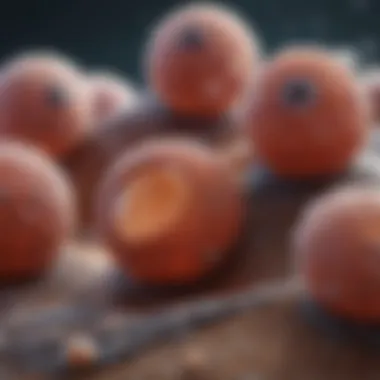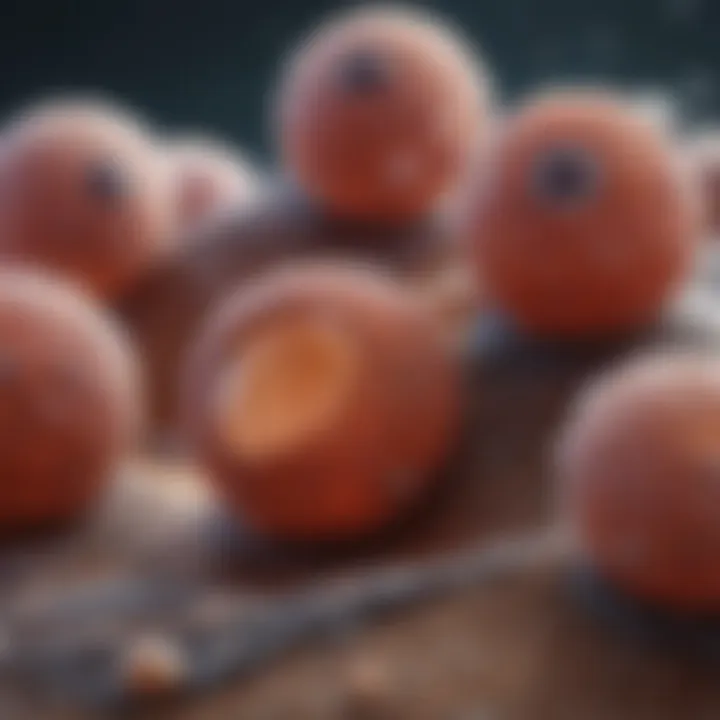Understanding Melanoma: Insights for Surfers


Intro
Melanoma, a term that sends shivers down the spine of many, is not just a buzzword; it's a growing concern, especially for those who ride the waves under the sun. Understanding this skin cancer requires more than just a superficial glance. Instead, we plunge deeper into its intricacies, exploring its origins, various types, risk factors, and the advances in treatments that have emerged in recent years. By gaining insights into melanoma, surfers and outdoor enthusiasts can better protect themselves and their skin while enjoying their passions.
Surfboarding Techniques
We start with the first step in our journey toward comprehension: how surfboarding techniques can influence skin health awareness. Many surfers might assume that as long as they’re having fun in the water, they’re safe, but that’s not the whole story. The sun's rays can be relentless, and understanding how to manage exposure while enjoying the surf becomes crucial.
Beginner Tips for Mastering the Basics
For those just paddling into the surf scene, here are some essential tips that go beyond riding the waves:
- Timing is Key: Surfing early or late in the day can drastically reduce UV exposure.
- Protective Gear is Not Optional: Rash guards and long-sleeve suits not only prevent rashes but also act as a barrier against harmful sun rays.
- Apply Sunscreen: Use broad-spectrum sunscreen with a high SPF. Reapply every two hours, especially after getting out of the water.
Advanced Techniques for Seasoned Surfers
For those who have honed their skills, incorporating skin protection into advanced techniques can prevent long-term health issues:
- Shadow Play: Make use of existing structures on the beach or natural features when taking breaks to shield yourself from the sun.
- The Right Surfboard Bag: Choose a bag that offers minimal sun exposure while carrying your board to and from the surf; look for UV-resistant materials.
Surfboard Equipment
The gear surfers use can also play a part in how they manage their exposure to sun and potential risk factors for melanoma. This section dives into what every surfboarder should consider.
Reviews of the Latest Surfboards on the Market
Surfers are often in the market for the perfect board that’s light, durable, and ideal for the waves they love. Here’s a look at recent favorites:
- Channel Islands
The Average Joe: This board blends performance with comfort and boasts an eco-friendly design, catering to those who care about sustainability. - Surftech
Soft Top: Ideal for a gentle entry into surfing, this board is not just kid-friendly but also minimizes the chance of injuries for those learning.
Essential Gear for Every Surfboarder
When it comes to protecting yourself, the right gear can make all the difference:
- Sunscreen: Stick formulas can be handy for easy application and to avoid drops of sunscreen in the ocean.
- Hat and Sunglasses: These are no-brainers; seek hat designs that can withstand windy conditions and polarized sunglasses that can reduce glare off the water.
- First Aid Kit: Having a well-equipped kit at hand means you can address those nicks and scrapes from both surfing mishaps and sunburn.
Surfers are not immune to skin cancers like melanoma; understanding disease risks and implementing proactive measures is key to a long, enjoyable journey on the waves.
In wrapping this up, as we face the sun and surf, knowledge shines a crucial light on safety and health. The more informed we are, the better equipped we become at enjoying our passions without paying a steep price later on.
Understanding Melanoma
Delving into melanoma is like peeling an onion—layer by layer, complexities reveal themselves. Understanding this specific type of skin cancer isn’t just about the medical jargon; it's about grasping the implications it holds for those who live life under the sun. Especially for surfers and outdoor enthusiasts, this knowledge can be indispensable.
Melanoma can be deceptive, which is why understanding its nature is paramount. Most often, it starts from benign moles that evolve into malignant tumors. For those who spend long hours basking in sunlight, the awareness of what melanoma entails is a necessary element to ensure long-term skin health and overall wellbeing.
Key benefits from gaining insight into melanoma include:
- Enhanced vigilance in self-examination, leading to early detection.
- Informed decisions about sun safety practices while enjoying outdoor activities.
- Fosters a deeper understanding of the current treatments and preventive measures available.
A balanced understanding also touches upon who gets melanoma. Notably, it isn’t just the fair-skinned individuals who need to be cautious; various factors influence its onset.
What is Melanoma?
At its core, melanoma is a form of skin cancer that develops from melanocytes, the cells responsible for pigment in the skin. It is considered one of the most aggressive forms of skin cancer, often stemming from atypical moles or even existing pigmentation on the skin. The rapid growth and potential to spread to other parts of the body distinguish melanoma from other skin cancers.
Melanoma does not discriminate; it can affect anyone regardless of their skin tone or background. Awareness and education are crucial—for surfers, instructors, and adventurers alike, knowing the signs of melanoma could mean the difference between life and death. Regular self-checks and understanding risk factors can play a pivotal role in mitigation.
The Types of Melanoma
Understanding the different types of melanoma is vital as they can vary significantly in appearance, behavior, and treatment strategies. Here, we’ll dive deeper into four prevalent types of melanoma:
Superficial Spreading Melanoma
Superficial spreading melanoma is one of the most common types and is often what people think of when they hear the term melanoma. Characterized by its irregular shape and variable colors, it typically starts on the skin’s surface before penetrating deeper layers.
This type is typically diagnosed at an early stage due to its distinctive appearance, allowing for higher treatment success rates. People often notice it due to the change in the look of a mole. Its poplularity stems from the knowledge among beachgoers about how to recognize changes in skin spots, making it easier to catch early.
Its unique feature is the presence of asymmetrical borders and various hues. This can be an advantage, as it often prompts individuals to seek medical advice sooner rather than later.
Nodular Melanoma
Nodular melanoma is another potent variant but comes carrying a distinct threat. Unlike the superficial type, nodular melanoma can appear more quickly, often as a dark nodule that can develop rapidly over weeks.
The notable characteristic of nodular melanoma is its vertical growth pattern, which can make it more aggressive. Because of this aggressiveness, it is crucial not to underestimate any new growth on one's skin, especially when it’s nodular in nature.
While it presents a unique challenge due to its fast-paced development, being aware of the warning signs and seeking early intervention can drastically improve outcomes.
Lentigo Maligna Melanoma
Lentigo maligna melanoma typically develops in sun-damaged skin. It often appears as a large brown patch, commonly seen on the face, neck, or hands of older adults. This type gives clues related to chronic sun exposure, where detection is possible due to its prolonged evolution.
A key aspect is its slow progression, allowing time for individuals to notice any changes. This can be beneficial in terms of recognition by outdoor enthusiasts who see skin changes over time. However, it can still become invasive if not monitored.
Acral Lentiginous Melanoma
Acral lentiginous melanoma is intriguing because it defies the stereotype of melanoma primarily affecting fair-skinned individuals. Instead, it is often found on the palms of hands or soles of feet, and occurs more frequently in people with darker skin.


What sets this type apart is its tendency to develop in areas that are not commonly exposed to sunlight. Despite being less common, its awareness is crucial for everyone, especially those often involved in outdoor pursuits.
Understanding these classes of melanoma is paramount, especially for surfers and outdoor enthusiasts. Education about melanoma types fosters proactive measures that can significantly impact their health outcomes.
Epidemiology of Melanoma
Understanding the epidemiology of melanoma is crucial, especially for those basking in the sun during long hours—surfers, outdoor enthusiasts, and adventure seekers alike. This segment of the discussion delves into the prevalence and incidence rates, detailing who is most at risk and where melanoma is most commonly found.
Prevalence and Incidence Rates
Melanoma isn’t just another skin ailment; its growing prevalence calls for attention. In recent years, data shows a significant uptick in cases worldwide. In specific regions, especially those with high UV exposure, the numbers can be staggering. For instance, Australia registers some of the highest ratings with approximately 14.8 cases per 100,000 people, standing testament to the sun's harshness. Similarly, the incidence in the United States has reached about 23.5 cases per 100,000 people. Such figures illustrate a pressing issue where sunlight exposure can be both recreational and hazardous. The earlier one spots warnings signs, the better.
Demographics Affected by Melanoma
Demographics play a pivotal role in understanding melanoma’s reach. Several factors such as age, gender, and geographic location provide insights into who is at most risk. Recognizing these demographics helps tailor preventive measures effectively for affected populations.
Age Groups
When it comes to age, melanoma is not selective but does show notable patterns. Traditionally, those aged 50 and above are at a greater risk, predominantly due to cumulative sun exposure over the years. Younger individuals also feel the sting, with a worrying rise in melanoma cases observed among the 15 to 29 age group. With surfing and outdoor activities appealing to younger generations, this trend has been a wake-up call, urging more awareness and protective measures.
- Key Characteristic: This demographic often exhibits a low perception of risk, wrongly believing that youthful skin offers an ample shield against the sun.
- Unique Feature: Young adults often neglect sun protection, drawn by the allure of the beach and outdoor activities without adequate measures. This naivety can be the Achilles heel in their sun safety strategy.
Gender Disparities
Gender disparities add another layer of complexity. Statistics indicate that men are more likely than women to develop melanoma, making them critical focuses in prevention campaigns. The relative carelessness of males regarding sun protection cannot be overstated.
- Key Characteristic: Men, especially, often embrace the outdoors and aren’t always vigilant about protective measures.
- Unique Feature: This atrisk behavior frequently leads to later-stage diagnoses and thus, poorer outcomes. Understanding these disparities is vital for developing targeted outreach.
Geographic Distribution
Where you live influences your melanoma risk. Areas that bask in the sun—with high UV index—like Florida or regions in Australia have higher melanoma rates compared to lesser-sunned regions.
- Key Characteristic: Residents in sun-soaked areas tend to have higher sun exposure, increasing their likelihood of developing the disease.
- Unique Feature: Certain areas, particularly coastal regions favored by beachgoers, showcase a stark contrast in skin cancer incidents compared to less exposed inland regions. Understanding local geography allows communities to implement effective educational measures.
"The journey to melanoma awareness begins with understanding the risks linked to one's environment and lifestyle."
Overall, recognizing the epidemiology of melanoma provides essential insights needed for mitigation strategies. It allows outdoor enthusiasts to enjoy their passions while staying ever so mindful of the silent risks lurking beneath the sun's warm embrace.
Risk Factors for Developing Melanoma
Understanding the various risk factors that contribute to melanoma is not just an academic exercise; it’s a matter of life and death for many individuals, particularly those in sun-soaked locales like coastal areas. The relationship between risk factors and melanoma underscores the importance of awareness, education, and proactive health choices, especially for surfers and outdoor enthusiasts who spend significant time under the sun's rays. Unlike other skin cancers, the intricacies of melanoma's origins involve a fascinating interplay between genetic factors, environmental triggers, and personal history, inviting readers to delve deeply into each element.
Genetic Predisposition
Certain people carry a genetic makeup that increases their risk of developing melanoma. These inherited traits, particularly mutations in genes such as BRAF and CDKN2A, can make one more susceptible. The fascinating aspect of genetic predisposition lies in its variability; not everyone with a family history will develop the disease, yet for those related to melanoma patients, vigilance is paramount. The unique feature here is that genetic counseling may provide crucial insights. Understanding one’s genetic risk allows for personalized strategies that could include increased surveillance or lifestyle modifications to mitigate risks.
Environmental Influences
Ultraviolet Radiation
Ultraviolet radiation is one of the main culprits when it comes to skin damage, directly linking to the development of melanoma. Sun exposure, especially without adequate protection, can lead to sunburns that inflict serious harm over time. The key characteristic of UV radiation is its ability to penetrate the skin deeply, causing mutations in DNA that may later evolve into malignant cells. For surfers who chase after waves and soak in the sunlight, the advantage of awareness about UV radiation cannot be overemphasized. The unique feature is that even brief exposure can be harmful, and repeated incidents accumulate over the years. It’s a reminder to prioritize sun safety practices consistently, rather than relying solely on sporadic precautions.
Geographical Location
The geographical locale where a person lives or frequents can heavily influence their risk of developing melanoma. Regions that experience high sun exposure and have clearer skies—such as Australia and parts of Florida—pose a significantly higher risk for skin cancer. This critical aspect highlights that some locations necessitate greater caution than others. By understanding the risks associated with specific areas, surfers can make more informed choices about how often and when to engage in outdoor activities. A unique factor to consider is that habits from home can sometimes mislead individuals who travel to sunnier climates, often leading to unexpected sun exposure.
Climate Impact
Climate plays an important role in skin health, with varying degrees of intensity regarding UV radiation based on weather patterns. Increases in temperatures and prolonged sunny days boost the risks associated with melanoma. The key characteristic of a changing climate is its unpredictable nature; hot and dry seasons can lead us to forget the essentials of sun protection. Climatic factors can also affect ocean and recreational water temperatures, which influences outdoor activity duration. The unique implication of climate change is that it may extend the risk periods that surfers and adventurers are exposed to without protective measures. Recognizing these patterns is crucial for developing a solid plan to combat skin cancer risks.
Skin Type and History
Aside from the genetic and environmental aspects, the type of skin you have and your personal history—like previous sunburns or skin lesions—can significantly alter your chances of getting melanoma. Lighter skin types generally have less melanin, making them more vulnerable to sun damage. The history of excessive sun exposure or previous tanning bed usage substantially elevates the risk. But skin type and history can also empower individuals; those aware of their unique risks can take steps to minimize them. Knowing your skin and being proactive in its care is crucial in safeguarding against melanoma.
Recognizing the Signs of Melanoma
Melanoma, while often seen as a distant possibility, is a reality that can creep up unexpectedly, especially for those who enjoy the sun-soaked life of surfing or other outdoor pursuits. Recognizing the signs of melanoma is crucial for early intervention and can mean the difference between a positive outcome and a more serious situation. The skin, our body's largest organ, is also its first line of defense against environmental hazards. Being aware of changes, however subtle, is an essential skill that anyone can cultivate, ensuring that potential problems are caught before they escalate.
The ABCDE Rule
The ABCDE Rule provides an easy-to-remember framework for identifying characteristics of moles that may indicate melanoma. Let’s break it down:
- A for Asymmetry: If you draw a line through the mole, the two halves won’t match. A normal mole is usually symmetrical.
- B for Border: Look for edges that are irregular, scalloped, or poorly defined. Melanomas can have uneven borders that stand out.
- C for Color: Varied pigmentation – shades of brown, black, tan, or even blue, white, or red – in the same mole can be a red flag.
- D for Diameter: Melanomas are typically larger than 6mm (about the size of a pencil eraser), but they can be smaller when detected.
- E for Evolving: Any change in size, shape, color, or elevation of a mole, or any new symptom such as bleeding, itching, or crusting, should be taken seriously.
"Early detection leads to more effective treatments and better outcomes in melanoma cases. Regular self-exams align well with an active lifestyle, providing both health and peace of mind."
Symptomatology Overview
Beyond the ABCDE Rule, melanoma presents with a range of symptoms that are important for surfers and outdoor enthusiasts to consider. Some common signs include:
- New Growths: Unexpected new spots on the skin that differ from your existing moles.
- Changes to Existing Moles: Any alterations in size, color, or texture can be significant.
- Itching or Pain: Moles that become itchy or painful might indicate a problem.
- Bleeding or Oozing: If a mole starts to bleed, ooze, or develop crusts, it's time to consult a doctor.
- Surrounding Area Changes: Redness or swelling around a mole can also raise suspicion.
Keeping a close eye on your skin isn’t just about cosmetic concerns; it’s about your health. Regularly taking a few moments to inspect your skin can save you from a lot of worry down the road. Remember, it's always best to err on the side of caution and consult a healthcare professional if you're uncertain about any changes.
Diagnosis of Melanoma
Diagnosing melanoma is a critical facet of managing skin health, especially for those who regularly spend time outdoors, like surfers and adventurers. Early diagnosis can significantly impact treatment outcomes and long-term survival rates. Taking a proactive stance in recognizing possible symptoms fosters not only awareness but also encourages individuals to seek medical advice promptly. This section will explore the key methodologies involved in diagnosing melanoma, focusing particularly on biopsy procedures and imaging techniques.
Biopsy Procedures


A biopsy is considered the gold standard for diagnosing melanoma. During this procedure, a sample of suspicious skin is removed and examined under a microscope for cancerous cells. The results offer a definitive diagnosis, determining not just the presence of melanoma but also its type and thickness – crucial factors that play a role in treatment decisions.
There are several types of biopsies:
- Excisional Biopsy: Complete removal of the suspicious mole or skin area. This method can yield the most comprehensive results.
- Incisional Biopsy: Only a portion of the lesion is removed, typically reserved for larger areas that cannot be surgically extracted entirely without cosmetic concerns.
- Shave Biopsy: A thin slice of the skin is taken, generally used for superficial lesions.
The choice of biopsy often hinges on the characteristics of the mole and the clinician's judgment, but each has its advantages and potential complications, emphasizing the need for a skilled hand in the diagnostic process.
Imaging Techniques
Alongside biopsies, various imaging techniques are employed to better understand the extent and severity of melanoma. These methods are essential for assessing whether the cancer has spread beyond the skin. Here are several prominent imaging techniques utilized in melanoma diagnosis:
Ultrasound
Ultrasound is used to evaluate lymph nodes and surrounding tissues for abnormalities.
- Key Characteristic: Non-invasive nature that provides real-time visualization of soft tissues.
- Benefit: Offers a clear view of the size and shape of lymph nodes, helping to determine any extra cancerous spread.
- Unique Feature: It doesn't involve any radiation exposure, making it a safer choice for repeat evaluations, particularly important for patients undergoing multiple assessments.
- Advantages and Disadvantages: While ultrasound is effective, it may not provide definitive answers about whether a node contains cancer. Hence, further diagnostic procedures may be needed.
CT Scan
CT scans provide a deeper look into the body, revealing details about tumors in various organs and lymph nodes.
- Key Characteristic: High-resolution images that showcase internal structures in cross-sectional views.
- Benefit: Ideal for comprehensive assessments, particularly in understanding metastatic disease.
- Unique Feature: Involves reconstructing data into 3D images can offer invaluable insights into tumor size and location.
- Advantages and Disadvantages: CT scans expose the patient to a measure of radiation. They can be expensive and sometimes over-sensitize to slight anomalies that may not imply cancer.
PET Scan
A Positron Emission Tomography (PET) scan is another powerful tool. It uses a radioactive substance to highlight areas of high metabolic activity, commonly seen in cancerous tissues.
- Key Characteristic: Visualizes how tissue absorbs the injected radioactive substance in real-time.
- Benefit: Offers the potential to discover metastasis not yet visible through other imaging methods.
- Unique Feature: Provides information about both the structure and function of tissues, distinguishing between benign and malignant lesions.
- Advantages and Disadvantages: While remarkable in identifying hypermetabolic regions, PET scans can generate false positives due to inflammation or infection.
Ending
"An ounce of prevention is worth a pound of cure" – Benjamin Franklin. This quote rings particularly true when it comes to melanoma awareness and diagnosis.
Treatment Modalities for Melanoma
The journey of dealing with melanoma is intricate, necessitating an understanding of various treatment modalities. For those in the surfboarding community, awareness of these treatments can be invaluable in navigating this formidable skin cancer. Treatments are not merely a response to diagnoses; they represent hope, options, and strategies to reclaim skin health.
Surgical Interventions
Surgical interventions stand as a cornerstone in the treatment of melanoma. This approach primarily aims to remove the tumor along with a margin of healthy skin surrounding it. The need for surgery is often contingent on how deep and wide the melanoma has spread. If the melanoma is detected early, a simple excision could very well be enough. However, more advanced cases might necessitate a process called lymph node dissection.
Factors to consider when evaluating surgical interventions include:
- Type and Stage of Melanoma: Each case varies greatly. A superficial spreading melanoma requires different surgical strategies compared to a nodular melanoma.
- Patient’s Overall Health: The health of the patient affects healing and recovery.
- Potential for Reconstruction: Post-surgery, reconstruction may be required to restore the skin’s appearance.
"Timely intervention can make a world of difference; knowing when to act is crucial."
Immunotherapy
Immunotherapy is a modern approach that empowers the body to battle melanoma by enhancing its immune response. Treatments like pembrolizumab or nivolumab harness the body’s own defenses to target and destroy cancer cells. More than just a treatment, it’s about rallying the body’s soldiers against disease.
The benefits and considerations of immunotherapy include:
- Effectiveness: Particularly effective for advanced melanomas or those resistant to other treatments.
- Side Effects: While it generally has fewer immediate effects than chemotherapy, it may cause the immune system to attack healthy tissues, leading to complications.
- Continuous Monitoring: Regular check-ups are necessary to assess effectiveness and adjust dosages as required.
Targeted Therapy
Targeted therapy offers a different path: it’s like using a laser instead of a broad hammer. This treatment targets specific genetic mutations in melanoma cells, such as the BRAF gene mutation. Medications like vemurafenib and dabrafenib can significantly slow down cancer growth. Here are key aspects to consider:
- Personalization of Treatment: Genetic testing can determine if a patient is a suitable candidate for targeted therapy.
- Side Effects: While often tolerated better than traditional chemotherapy, patients may experience side effects like fever, rash, or joint pain.
- Combination with Other Treatments: Targeted therapy may be combined with immunotherapy for a more robust response.
Preventive Measures Against Melanoma
Preventing melanoma is crucial, especially given its rising incidence among those who spend long hours outside. Suncare isn’t just about seeking shelter from the burning rays; it’s a lifestyle choice that encourages a healthier interaction with the environment. Melanoma can sneak up on even the most vigilant of us, making education and proactive measures non-negotiable.
Regular Skin Checks
Regular skin checks are a cornerstone of melanoma prevention. Noticing changes early can mean the difference between a swift recovery and a long battle. It's recommended to examine your skin at least once a month. Familiarize yourself with moles, freckles, and patches - treat your skin like an old friend, one whose quirks you know by heart. Look for new growths or changes in existing spots. What should you look for? Pay close attention to asymmetry, irregular borders, color variations, and larger-than-average spots. If something feels off, don’t hesitate to get it checked.
Getting familiar with your skin's map may also boost your confidence. For those frequent beachgoers or surfers, it can even become a part of your post-surf routine. Having a buddy system for skin checks can prove helpful, too, as friends often notice what you might miss.
Sun Safety Guidelines
Making sun safety a habit rather than an afterthought can significantly reduce potential melanoma risks.
Sunscreen Use
Using sunscreen is akin to wearing an invisible shield; it protects your skin from harmful UV rays. Opt for broad-spectrum protection of at least SPF 30, which blocks about 97% of UVB rays. One of the key characteristics of sunscreen is its ability to absorb, reflect, or scatter sunlight, providing a critical barrier against potential skin damage.
Reapplication is essential. Every two hours or more often if swimming or sweating ensures that you’re providing constant protection. Pick a sunscreen with water resistance if you're spending time in the ocean.
Additionally, choosing the right sunscreen should not be neglected. Look for products containing zinc oxide or titanium dioxide for advanced protection against UV rays. The unique feature of physical sunscreens, like these ingredients, is their ability to create a barrier that sits on top of your skin, thus deflecting sunlight rather than absorbing it.
Protective Clothing
Investing in protective clothing could be one of the smartest things to do amidst endless sun-soaked days. These garments are made from tightly woven fabrics that offer an extra layer of protection. A significant benefit of wearing protective clothing is its simplicity—you put it on, and voila, you’re shielded from harmful rays.


Look for garments with a UV Protection Factor (UPF) label, which tells you how much UV radiation can penetrate the fabric. A high UPF rating indicates significantly better protection. The unique selling point of protective clothing over sunscreen is its durability; you don’t need to worry about reapplication or wearing it off.
However, many outdoor enthusiasts may find it a bit bulky or restrictive, and finding the right balance of comfort and functionality is key.
Shade Seeking
When outdoors, don’t underestimate the importance of shade. Seeking cover from direct sunlight habitually not only protects your skin, but it can also keep you cool and prevent overheating. The key characteristic of shade seeking is its proactive approach; you’re not just dodging the sun’s rays but also enjoying your environment more comfortably.
Utilizing umbrellas, trees, or canopies are practical solutions for reducing exposure. It’s a simple adjustment—sip a drink under an umbrella or plan your beach activities around less sun-intensive hours. The particular advantage is that this option can easily fit into any outdoor plan without special equipment or products.
However, be mindful that shade can be deceptive. Just because you’re under a tree doesn’t mean you’re safe. UV rays can reflect off surfaces like water, sand, or even concrete, affecting you regardless.
"An ounce of prevention is worth a pound of cure."
By embracing these preventive measures, surfers and outdoor enthusiasts alike can significantly minimize their risk of melanoma. Awareness and action are the best surfs against the skin’s silent adversary.
Living with Melanoma
Living with melanoma can be a daunting journey. The diagnosis impacts many facets of a person's life—physically, emotionally, and socially. It's crucial to emphasize that understanding melanoma goes beyond just knowing its medical aspects. This segment digs deeper into what living with melanoma entails and how to cope with the myriad challenges it presents.
Emotional and Psychological Impact
Receiving a melanoma diagnosis can be akin to a sudden earthquake in one's life. The emotional upheaval can range from disbelief and fear to anxiety and depression. Many find themselves grappling with a flood of questions: How will this affect my life? Will I need extensive treatments? What if it returns?
The constant worry can lead to a sense of isolation, as thoughts race ahead to future uncertainties. Coping mechanisms become essential. Engaging with therapeutic services, support groups, or even speaking to a healthcare provider can provide an anchor during tumultuous times. For some, sharing their experiences or fears with loved ones helps to lessen the load.
Moreover, mental health professionals can guide individuals to address these feelings effectively, fostering resilience. Meditative practices or mindfulness have shown to alleviate stress, creating a smoother path towards acceptance. Embracing a proactive mindset can empower patients, shifting the focus from fear to management.
Support Resources
Living with melanoma often necessitates leaning on external resources for support. Various platforms and organizations provide guidance, community, and advocacy for patients and their families. Here’s a closer look at two significant support resources:
Online Communities
Online communities serve as a virtual refuge for those navigating the complexities of melanoma. These platforms offer a unique space to connect with others facing similar challenges, which can be vital when seeking reassurance and sharing experiences. Many find solace in knowing they are not alone.
A defining characteristic of these communities is their 24/7 accessibility. Whether someone needs to converse late at night or exchange advice on treatment options, these communities allow for immediate interaction. Additionally, the anonymity of online interactions often encourages individuals to open up more freely than they might in a face-to-face setting.
However, it’s essential to tread carefully when sifting through information. Not all advice is created equal; discerning reliable sources from misinformation is crucial. Despite this, the supportive environment of online forums generally leads to uplifting exchanges and tips benefitting those impacted by melanoma.
Patient Advocacy Groups
Patient advocacy groups play a pivotal role in the larger dialogue surrounding melanoma. These organizations often focus on promoting awareness, funding research, and aiding patients in navigating their journeys. A key point is their dedication to awareness campaigns which strive to educate the public about melanoma, its risks, and prevention tips.
For patients, these groups can be instrumental in developing a solid support network. They provide resources that range from legal assistance to navigating healthcare systems. Their emphasis on collective action stands out, aiming to ensure that the melanoma community has a unified voice when it comes to policy-making and healthcare reforms.
However, like any organization, it's crucial to research the values and mission of an advocacy group before engaging. Some groups are better aligned with individual needs than others. Nonetheless, the sense of community fostered by these entities often empowers patients to take charge of their health decisions.
"Living with melanoma is not just a fight for survival; it's about embracing each moment, fostering connections, and finding strength through adversity."
In summary, living with melanoma is undoubtedly challenging. However, incorporating emotional support, utilizing online communities, and engaging with patient advocacy groups can significantly enhance one's journey. Awareness, understanding, and connection pave the way toward a more manageable existence amidst the complexities of melanoma.
Future Directions in Melanoma Research
Exploring the future of melanoma research is vital. This area focuses on the evolution of treatments and technologies that could significantly impact how we approach prevention, detection, and management of melanoma. With growing incidences of this skin cancer, innovations in research are at the forefront of combating its spread. As surfers, who often spend extended periods under the sun, understanding these advancements can empower you to stay informed, ensuring better skin health in the long run.
Novel Therapies on the Horizon
The arena of melanoma treatment is evolving rapidly, promising novel therapies that could change the game entirely. Here are a few notable developments:
- Targeted Therapy Enhancements: New drugs are being designed to target specific mutations within melanoma cells. For instance, therapies targeting the BRAF mutation have shown promise and are being refined for more effective application.
- Combination Therapies: Research is increasingly showing that combining therapies — such as immunotherapy and targeted treatments — can yield better results than single-agent therapies alone. This approach leverages multiple mechanisms to combat the melanoma effectively.
- Adjuvant Treatments Development: Efforts are underway to identify effective adjuvant therapies that can be used post-surgery to minimize the risk of recurrence. These include a tailored regimen, potentially offering a personalized approach to melanoma recovery.
"Innovation in melanoma therapies enhances survival rates and quality of life for those impacted by this condition."
Such innovations not only provide hope but also open the door for specialized treatments that account for individual patient profiles — something that is increasingly relevant given the diverse range of melanoma cases.
The Role of Artificial Intelligence
Artificial intelligence (AI) plays an important role in advancing melanoma research and treatment. Its integration into medical practices is changing how we diagnose and monitor skin cancer. Here are key aspects where AI provides value:
- Enhanced Diagnostic Tools: Algorithms can analyze images of moles or skin lesions faster and with often higher accuracy than the average human eye. Tools that leverage machine learning can improve screening processes, making early detection more accessible.
- Predictive Analytics: AI can assist in predicting melanoma’s behavior and progression based on historical data and patient records. This predictive capacity is crucial for customizing treatment plans that cater to an individual’s unique cancer profile.
- Data Management and Research: With vast amounts of medical data available, AI helps researchers sift through this information efficiently, uncovering vital correlations and insights that might be missed otherwise.
By incorporating AI, the healthcare landscape in melanoma research transforms, yielding insights that equip both medical professionals and patients with better tools for addressing this prevalent condition. The future is bright, yet it calls for mindfulness, especially for those who cannot always avoid sun exposure.
Closure
When it comes to understanding melanoma, grabbing hold of the key insights isn't just about knowledge. It's about weaving these facts into the very fabric of our lives, especially for those who thrive in outdoor settings, like surfers and adventurers. The unfolding narrative around melanoma allows for a richer appreciation of how this skin cancer works and its far-reaching implications.
Summarizing Key Insights on Melanoma
If there’s one thing you should remember, it’s that melanoma isn’t just any old skin issue; it’s a serious condition that demands attention. Recent research uncovers how UV exposure, particularly for those who love the sun, raises risk levels. Here are some pivotal takeaways:
- Types of Melanoma: Familiarize yourself with the various types, as early recognition can be life-saving. Superficial spreading melanoma, lentigo maligna, and nodular melanoma all present differently.
- Risk Factors: Be aware of the culprits that elevate your chances, notably family history, fair skin, and geographical location. This can influence whether you're at a greater risk compared to others within your community.
- Prevention Strategies: Armed with sun safety practices can be a game-changer. Regularly applying sunscreen and protective clothing might feel cumbersome at times, yet these small actions hold a wealth of power in safeguarding your skin.
Integrating these insights into your awareness equips not just yourself, but also your loved ones. Awareness acts as a shield, enabling proactive measures against this insidious foe.
Call to Action for Awareness
Melanoma’s silent advance calls for action - and it requires each one of us to be vigilant. It’s high time we turned our knowledge into advocacy. Here’s how you can step up:
- Spread the word to your fellow adventurers. Increasing visibility sparks discussion, and awareness is the first step toward change.
- Use community platforms like Reddit and Facebook to share personal experiences, which can resonate deeply with others facing similar challenges.
- Advocate for community skin check events targeting local surfers and outdoor enthusiasts, making it easier for everyone to get screened.
Remember, a little awareness can go a long way. Making skin checks part of your routine could mean the difference between life and death. Your skin, with all its stories, deserves care.
As this journey through melanoma awareness wraps up, let’s take the insights gained and combine them with proactive action. Think of it not as a burden, but as a way to honor your passion for adventure while protecting the one body you have. Each small step counts, leading to big changes in how we understand and confront melanoma in the future.















